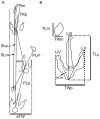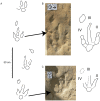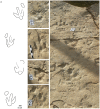Manus track preservation bias as a key factor for assessing trackmaker identity and quadrupedalism in basal ornithopods
- PMID: 23349817
- PMCID: PMC3551957
- DOI: 10.1371/journal.pone.0054177
Manus track preservation bias as a key factor for assessing trackmaker identity and quadrupedalism in basal ornithopods
Erratum in
- PLoS One. 2013;8(9). doi:10.1371/annotation/e0dba720-9eda-4457-ae59-24d9d96eb8c8
Abstract
Background: The Las Cerradicas site (Tithonian-Berriasian), Teruel, Spain, preserves at least seventeen dinosaur trackways, some of them formerly attributed to quadrupedal ornithopods, sauropods and theropods. The exposure of new track evidence allows a more detailed interpretation of the controversial tridactyl trackways as well as the modes of locomotion and taxonomic affinities of the trackmakers.
Methodology/principal findings: Detailed stratigraphic analysis reveals four different levels where footprints have been preserved in different modes. Within the tridactyl trackways, manus tracks are mainly present in a specific horizon relative to surface tracks. The presence of manus tracks is interpreted as evidence of an ornithopod trackmaker. Cross-sections produced from photogrammetric digital models show different depths of the pes and manus, suggesting covariance in loading between the forelimbs and the hindlimbs.
Conclusions/significance: Several features (digital pads, length/width ratio, claw marks) of some ornithopod pes tracks from Las Cerradicas are reminiscent of theropod pedal morphology. This morphological convergence, combined with the shallow nature of the manus tracks, which reduces preservation potential, opens a new window into the interpretation of these tridactyl tracks. Thus, trackmaker assignations during the Jurassic-Cretaceous interval of purported theropod trackways may potentially represent ornithopods. Moreover, the Las Cerradicas trackways are further evidence for quadrupedalism among some basal small- to medium-sized ornithopods from this time interval.
Conflict of interest statement
Figures













References
-
- Farlow JO, Lockley MG (1993) An osteometric approach to the identification of the makers of early Mesozoic tridactyl dinosaur footprints. In: Bulletin of the New Mexico Museum of Natural History and Science Lucas SG, Morales M, editors. The nonmarine Triassic. 3: 123–131.
-
- Matsukawa M, Hamuro T, Mizukami T, Fujii S (1997) First trackway evidence of gregarious dinosaurs from the Lower Cretaceous Tetori Group of eastern Toyama Prefecture, central Japan. Cretaceous Research 18 (4): 603–619.
-
- Moratalla JJ, Sanz JL, Jiménez S (1997) Información paleobiológica y paleoambiental inferida a partir de las icnitas de dinosaurios: problemas, límites y perspectivas. Revista Española de Paleontología 12: 185–196.
-
- Farlow JA, Chapman RE (1997) The scientific study of dinosaur footprints. In: Farlow JA, Brett-Surman MK, editors. The Complete Dinosaur. Bloomington and Indianapolis: Indiana University Press. 519–553.
-
- Lockley MG, Santos VF, Meyer C, Hunt A (1998) A new dinosaur tracksite in the Morrison Formation, Boundary Butte, Southeastern Utah. In: Modern Geology 23 Carpenter K, Chure D, Kirkland K, editors. The Upper Jurassic Morrison Formation: An interdisciplinary study. (2): 317–330.
Publication types
MeSH terms
LinkOut - more resources
Full Text Sources
Other Literature Sources

